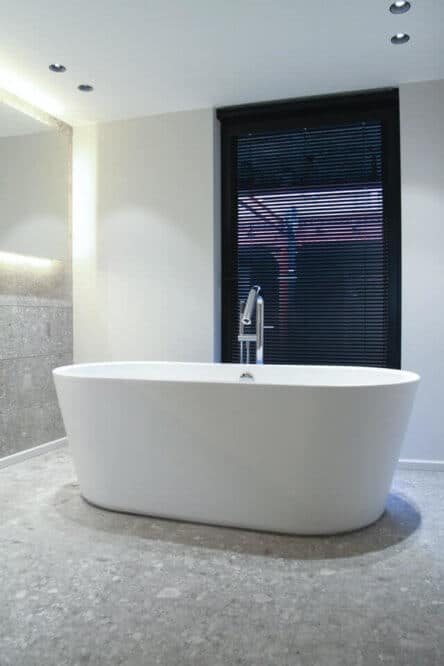If you are considering a new bathtub, there are various options on the market. However, acrylic and porcelain bathtubs are two of the popular choices consumers consider. Therefore it is essential to understand the difference between the two before making a purchase. By looking at our acrylic vs porcelain tub comparison, you can make an informed decision.
Which Is The Best Bathtub Material? Acrylic vs Porcelain Tub

Since there are various types of bathtubs on the market, acrylic or porcelain are not your only choices. The best bathtub material for your bathroom will depend on your priorities.
For some people, the style of the tub is essential, while for others, it is better to install something more practical. In many cases, the cost of the bathtub itself and the ease of installation will make or break the deal.
If you believe in safety first, the safest bathtub material would be a priority. However, most manufacturers legally guard their fabrication process. This makes it difficult to know for sure what is the safest bathtub material.
Nonetheless, bathtub products have to meet minimum government standards in the USA. This means that if you are buying from local USA manufacturers, the tub should generally meet safety requirements. [1]
How Are Porcelain Tubs Constructed

These bathtubs are made from cast iron or stamped steel coated with a layer of porcelain enamel. Porcelain is the result of fusing powdered glass into a thin substrate via a heating process. [2] After this powered glass melted, it turned into a durable hard coating and serves as a finish for the tub.
How Are Acrylic Tubs Constructed?
Acrylic tubs mainly consist of acrylic vacuum-formed sheets. [3] These sheets are often reinforced with fiberglass to enhance durability. The material is soft and supple, which allows it to be formed into a large variety of tub shapes and sizes.
To thoroughly compare acrylic vs porcelain tubs, we will look at the following features:
- weight
- heat retention
- cost
- durability
- maintenance
- restoration
- popularity
- reliability
Weight
Acrylic is a lighter material than porcelain. Therefore, when it comes to installation and placement, an acrylic tub will be more flexible. Acrylic is easier to manipulate because it is lighter. This means there are a much more comprehensive range of shapes and sizes on the market.
When it comes to porcelain, however, the additional weight makes the shapes and sizes limited. It is harder to install if that shape and size do not fit properly in the tub area in your bathroom.
Heat Retention
Acrylic tubs are better at heat retention. The reinforced fiberglass of which acrylic tubs are made creates a contiguous bond with no other material to get in the way.
Porcelain tubs, on the other, consist of layers of porcelain coating over an iron or metal base. The separation between the coating and structural material will allow heat to release much faster. However, some porcelain tubs contain foam insulation which helps to retain heat for longer.
Cost
In general, porcelain bathtubs are more expensive than acrylic. Besides the retail price, porcelain tubs also cost more to install and maintain. Acrylic tubs are cheaper due to the nature of the material, and also easier to maintain and install.
Durability
One would think that porcelain tubs are more durable because they contain a much harder surface. However, the opposite is true; porcelain is much more susceptible to cracks and chipping during a heavy impact.
While acrylic can withstand a hard impact much easier, porcelain tubs are less prone to scratches than acrylic.
Maintenance
When it comes to maintenance, a similar amount of care should be applied to porcelain and acrylic tubs. Both of these types of material need to be carefully cleaned to avoid damage.
Acrylic bathtubs can be cleaned with a commercial-based cleaner while porcelain cannot. It is best to wash porcelain tubs with a natural homemade cleaning solution.
One should also take care not to use steel wool or any abrasive brushes on a porcelain tub. Both of these types of tubs may discolor over time if proper care is not taken.
Restoration
While it is a bit easier to restore an acrylic tub, restoration is the same for acrylic and porcelain tubs. Damage to an acrylic bathtub can be repaired with a refining kit.
Acrylic tub restoration usually involves reapplying a coating over the surface to remove many of the initial blemishes.
For porcelain tubs, one can also find refinishing kits in store for a DIY bathtub restoration project. However, in many cases, it is advised to hire a professional to restore a porcelain tub.
Popularity and Re-sellability
Both porcelain tubs and acrylic bathtubs are pretty popular. Therefore the resell value of both will be high. Acrylic bathtubs can be easily incorporated into any color scheme and fit in great in a modern bathroom.
Because porcelain bathtubs have a classic look and feel, they used to command more value on resale. However, today, both these materials are favored.
Best Acrylic Bathtub To Choose From:

Woodbridge Resin, Contemporary Resin Bathtub
This bathtub is very contemporary with its acrylic finish. It is constructed out of a mix of resin and brushed nickel to ensure durability and sturdiness.
The Woodbridge resin tub offers a natural curve that enhances the comfort level of your body. It is also straightforward to clean and maintain as it won’t stain. The flexible tube drain it comes with provides an ergonomic fitting to help avoid leaks or air holes while using.
Ferdy Assembled – White Acrylic Bathtub
The white Ferdy Assembled bathtub is a white acrylic bathtub, which is sculpted to go along with the curve of your body. The natural slope provides one’s body with the necessary lumbar support. Its large size and width are great for deep and relaxing soaks.
This tub has a glossy finish that consists of resin materials. Thus this tub is lightweight yet sturdy. To prevent clogging, it also has a toe-tap drain system. The reinforced fiberglass of which this tub is made makes it durable, non-toxic, and non-cracking.
Fine Fixtures Fiberglass – Compact Acrylic Bathtub
If you have a small space, the Fine Fixture acrylic bathtub might be ideal. This tub can fit in a small room yet provide ample space for a relaxing bath. The acrylic fiberglass material it is made of is crack resistant and gives a glossy porcelain finish. It is also slip-resistant and can be installed easily on either side of the drain.
Kingston Brass Contemporary – Alcove Acrylic Bathtub
Another contemporary design is the Kingston Brass alcove acrylic bathtub. This drop-in tub holds a capacity of 58.2 gallons which is terrific for a deep soak. It is reinforced with fiberglass and resin material that gives it durability. It is easy to install this tub as it is lightweight and easy to move around. It will not stain and scratch, and it gives an uplifting appearance.
Refurbishing? How To Know What Material Your Tub Is Made Of?

If you are renovating your bathroom and want to refurbish your tub, you might be wondering, “Is my tub acrylic or porcelain?” It is crucial to know what materials you are working with to use the proper refurbishing process. Here are some things you can do to determine what type of material your tub is made of.
Press on the Side of the Bathtub
If you press on the side of your bath, it will either give in a little or not at all. The chances are good that your tub is made of acrylic fiberglass if it flexes a bit. A porcelain enameled steel bathtub is too hard to flex under pressure.
Inspect Surface Damage
Inspect the tub’s surface to figure out the type of damage that has occurred over the years. A porcelain enameled steel bathtub will not crack easily, but it can chip if hard objects fall on them. Rust may be visible in chips if the tub is made of metal. A fiberglass or acrylic tub is more likely to have cracks or scratches on the surface. Fades may also occur in fiberglass bathtubs, especially if the bathtub is colored.
Hold a Magnet to the Tub
A strong magnet placed on the wall of steel and cast iron tub will stick. If a magnet does not stick to a bathtub, it is a good indicator that the material is fiberglass or acrylic.
Look for Extra Supports
A heavy tub would most likely need extra support beneath it. This is usually the case for iron tubs. If there is some framing around your tub you can remove the access panel and look for additional support. A clawfoot tub is made of cast iron in most cases, but some are constructed from fiberglass.
Overview On Acrylic vs Porcelain Tubs
When you compare acrylic vs porcelain tubs, you will find that acrylic bathtubs are much more versatile. Overall, acrylic tubs are more durable, easier to install, hold heat better, and offer more design and style choices.
Nonetheless, despite the advantages acrylic tubs offer, nothing can beat the classical look that a porcelain tub provides. So, it will most likely come down to the look you want if you choose between a porcelain and acrylic tub. Yet by understanding the pros and cons of both materials, you will know what you are getting yourself in for in the long run.

Michael Davis is a heating & plumbing expert who currently works as independent contractor in SC. He also writes for Plumbertip.
For almost 10 years he worked on various plumbing tasks across South Carolina.



